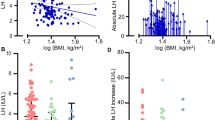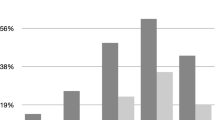Abstract
The Hypogonadism In Males study estimated the prevalence of hypogonadism in men aged ⩾45 years. A sub-analysis of patients not receiving testosterone (T) therapy was conducted. Blood draw times were 0800–1000 and 1000–1200 hours. Total T (TT) was not influenced by draw time for any age group; however, significantly greater free T (FT) and bioavailable T (BAT) values were observed in the overall population for earlier draw times. Sex hormone-binding globulin (SHBG) values were significantly lower in men aged 45–64 years at the earlier draw time. In men aged ⩾75 years, no significant differences in TT, FT, BAT or SHBG were observed on the basis of draw time. Early morning draw time may not be critical for capturing TT concentrations in men ⩾45 years; however, when measuring FT or BAT, an early morning draw time may be preferable for men aged <75 years.
This is a preview of subscription content, access via your institution
Access options
Subscribe to this journal
Receive 8 print issues and online access
$259.00 per year
only $32.38 per issue
Buy this article
- Purchase on Springer Link
- Instant access to full article PDF
Prices may be subject to local taxes which are calculated during checkout

Similar content being viewed by others
References
Gupta SK, Lindemulder EA, Sathyan G . Modeling of circadian testosterone in healthy men and hypogonadal men. J Clin Pharmacol 2000; 40: 731–738.
Winters SJ . Diurnal rhythm of testosterone and luteinizing hormone in hypogonadal men. J Androl 1991; 12: 185–190.
Bremner WJ, Vitiello MV, Prinz PN . Loss of circadian rhythmicity in blood testosterone levels with aging in normal men. J Clin Endocrinol Metab 1983; 56: 1278–1281.
Mulligan T, Frick MF, Zuraw OC, Stemhagen A, McWhirter C . Prevalence of hypogonadism in males aged at least 45 years: the HIM Study. Int J Clin Pract 2006; 60: 762–769.
Diver MJ, Imtiaz KE, Ahmad AM, Vora JP, Fraser WD . Diurnal rhythms of serum total, free and bioavailable testosterone and of SHBG in middle-aged men compared with those in young men. Clin Endocrinol (Oxford) 2003; 58: 710–717.
Mohr BA, Guay AT, O'Donnell AB, McKinlay JB . Normal, bound and nonbound testosterone levels in normally ageing men: results from the Massachusetts Male Aging Study. Clin Endocrinol (Oxford) 2005; 62: 64–73.
Bhasin S, Cunningham GR, Hayes FJ, Matsumoto AM, Snyder PJ, Swerdloff RS et al. Testosterone therapy in adult men with androgen deficiency syndromes: an Endocrine Society clinical practice guideline. J Clin Endocrinol Metab 2006; 91: 1995–2010.
Morgentaler A . Commentary: guideline for male testosterone therapy: a clinician's perspective. J Clin Endocrinol Metab 2007; 92: 416–417.
Luboshitzky R, Shen-Orr Z, Herer P . Middle-aged men secrete less testosterone at night than young healthy men. J Clin Endocrinol Metab 2003; 88: 3160–3166.
Vermeulen A, Kaufman JM . Ageing of the hypothalamo-pituitary-testicular axis in men. Horm Res 1995; 43: 25–28.
American Association of Clinical Endocrinologists. Medical guidelines for clinical practice for the evaluation and treatment of hypogonadism in adult male patients—2002 update. Endocr Pract 2002; 8: 440–456.
Gray A, Feldman HA, McKinlay JB, Longcope C . Age, disease, and changing sex hormone levels in middle-aged men: results of the Massachusetts Male Aging Study. J Clin Endocrinol Metab 1991; 73: 1016–1025.
Acknowledgements
Solvay Pharmaceuticals Inc. provided financial support for this study and editorial assistance in the preparation of this paper. Dr Guay has served on advisory boards for Auxilium, Oscient, Solvay, Cellegy, Procter & Gamble and Indevus. He has participated in speakers' bureaus for Auxilium, Oscient and Solvay and has been the recipient of research grants from Auxilium, Solvay and Cellegy. Dr Miller and Ms McWhirter are employees of Solvay Pharmaceuticals Inc.
Author information
Authors and Affiliations
Corresponding author
Rights and permissions
About this article
Cite this article
Guay, A., Miller, M. & McWhirter, C. Does early morning versus late morning draw time influence apparent testosterone concentration in men aged ⩾45 years? Data from the Hypogonadism In Males study. Int J Impot Res 20, 162–167 (2008). https://doi.org/10.1038/sj.ijir.3901580
Received:
Revised:
Accepted:
Published:
Issue Date:
DOI: https://doi.org/10.1038/sj.ijir.3901580
Keywords
This article is cited by
-
Testosterontherapie
Die Urologie (2022)
-
Association of low testosterone with changes in non-cardiovascular biomarkers in adult men
International Journal of Impotence Research (2020)



